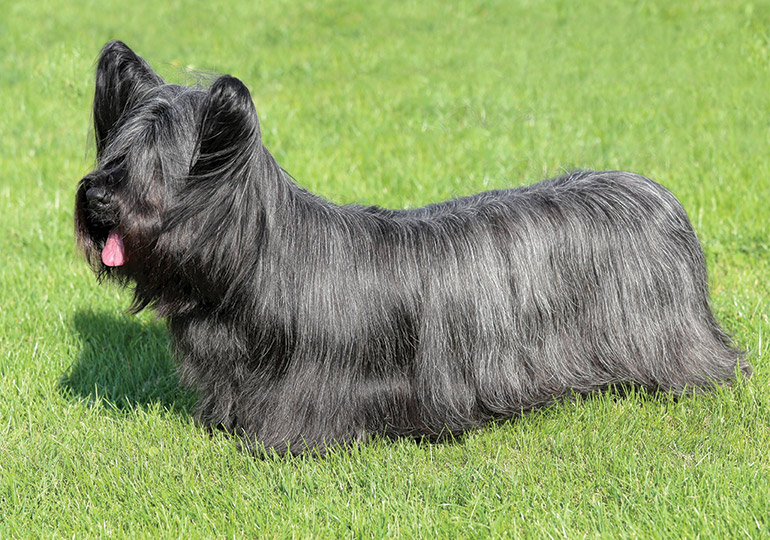Breeds
Skye Terrier

GROUP 2 - TERRIERS
History
The Skye Terrier originated approximately four centuries ago on the Isle of Skye, Scotland. It was bred by farmers as a hardy Terrier, with immense courage and loyalty. The Skye Terrier would follow the scent of vermin, such as fox and badger. An agile worker in rocks, the breed’s keen sense of smell and flexible body helped it to locate vermin underground as well. The Skye Terrier’s short, sturdy legs were well suited for digging, and the double coat protected it from the wet weather.
Appearance
A stylish and elegant dog, best described as long, low and level, the Skye Terrier is a strong dog with a profuse coat that falls straight down to the ground.
It is 25cm tall and approx 1.4m long, from nose to end of tail, and weighs approximately 12-15kg. The breed can have either drop or prick ears. Originally, the drop-eared variety was favoured for farm work, but later, in the nineteenth century, the erect-eared variety became more popular as a pet and show dog, partly as a result of Queen Victoria’s fondness for the breed. The erect ear is large, with beautiful black feathering that frames the face. The Skye Terrier is bred in a range of colours including cream, silver, grey and black. The ears and nose on all colours must be black.
Temperament
The breed is affectionate and willing to please, and has the temperament of a typical working Terrier; it is fearless and very loyal to its master. It is a ‘one man’ dog and can be distrustful of strangers, but never vicious. The breed enjoys being part of the family. The Skye Terrier excels at many different disciplines including, but not limited to, Obedience, jumping, Agility and showing. It enjoys learning new things and is keen to make things a game.
Health
The Skye Terrier is a reasonably hardy Terrier, with a lifespan usually in excess of 10 years. There are some health issues that can affect the breed including early closure of growth plates in the front legs, and Renal Dysplasia has been noted in the breed, although not in large numbers. Screening programs are currently being developed to eradicate this.
Maintenance
Regular grooming for the Skye Terrier in full coat requires a good brush through a couple of times a week. Always pay attention to behind the ears and the legs, as the coat can become knotted in these areas. Bathing and nail clipping should be undertaken regularly, and ears cleaned and checked. The hair under the pads can be trimmed as required. The breed will usually shed the softer undercoat once or twice per year.
Suitability
The Skye Terrier is a multipurpose Terrier, with an inquisitive nature. The breed makes a loyal family dog that requires a reasonable amount of exercise per day. It does enjoy being part of the family and doesn’t like being left out of activities. The breed can benefit from basic Obedience training as it is a strong dog. The Skye Terrier is a wonderful companion and usually gets along well with other dogs.
Words: Sandy Wesselink
Image: Shutterstock.com
In Conclusion
Now you know a little about the Skye Terrier, you may think that this is the dog for you. Before you make a decision, please make contact with the breed club or your State controlling body for purebred dogs. They will be able to give you information about available puppies and also suggest dog shows where you can see the breed and speak to breeders. In this way you will gain a better perspective of the Skye Terrier and its needs, and whether this breed would suit your lifestyle.
Breeders
Sorry, there are currently no breeders advertising for this breed. If you are a registered DOGS NSW breeder and wish to advertise here please create an advertisement here.


